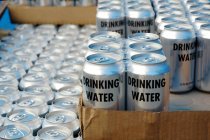Water Disinfection
For Buildings, Hospitals and Hotels
Various methods have been developed to disinfect water in large commercial and residential buildings, hotels and hospitals.
One of the oldest methods for drinking water disinfection is chlorination: Usually a gas bottle of chlorine gas is connected to the main utility port of the building. From there the disinfection solutions is feed into the buildings pipework. Disinfection is thus achieved relatively reliable, but dealing with the toxic gas chlorine is dangerous and specially trained staff is required. After all it is a substance, which was used as a chemical warfare agent in the 1st World War. In addition, the water gets a noticeable chlorine odor and taste of chlorine, which can have a noticeable effect on food and beverage preparation, which might irritate consumers.
Newer procedures for water disinfection are UV disinfection, ozone or ultrafiltration. When correctly applied, in particular, in compliance with flow through rates and maintenance manuals water disinfection can be accomplished over those methods. The disinfection typically takes place at a central location in the building, near the main water line. However, often there is no particular germ problem at that stage if the municipal water supply already has a high quality. The problem of contamination with germs, that occurs once the water is feed in to the buildings pipework, is not addressed: because all three methods have no depot effect. In addition, all three methods require high maintenance and are energy-intensive, thus ecologically questionable.
REDO Technology is the answer to the challenges faced in facility management: the REDO system was developed on the basis of an electrolysis process. Only a few grams of common salt and a very small amount of energy are required to disinfect 1,000 litres of water. To accomplish this a small amount of water is taken from the main water line. This water is fed into the cabinet-sized REDO system where the disinfection liquid REDOlyt is produced. This disinfection liquid is then fed back into the main water line. Any existing contamination is eliminated immediately. In addition, a long-term depot effect prevents the formation of biofilms in the pipework and re-contamination in the water distribution network of the building. The advantages can be summarized as follows:
- No security risks in the production and application of the disinfectant
- No safety risks during transport and storage of hazardous substances
- Avoidance of toxic or carcinogenic disinfection by-products (THMs)
- Prevention of biofilm formation
- Excellent depot effect throughout the pipework
- No chlorine smell and taste
- No costly water dispenser required
- Low operational costs and low maintenance
- Improved image and public perception, due to higher safety and better health protection
Cooperation
Clean Water Fund

INWASOL and the Clean Water Fund have developed a special solution for water projects:
Due to a strong partnership with the Clean Water Fund, INWASOL is not only able to provide its customers with an innovative German water disinfection technology, but also with several financing solutions.
We are looking forward to your inquiry. There is a suitable solution for every customer.
